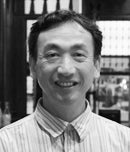Yasumoto KajiwaraYasumoto Kajihara
-
ギャラリー一番館
からのご紹介 - 陶歴・プロフィール
-
It is said that Mr. Kajiwara is the person currently devoting his energies to restoring old Karatsu. Using sandstone as the raw material for old Karatsu, which was originally clay, he has been creating Karatsu pottery for ten years that experts have described as "old Karatsu itself."
Since 2001, he has been visiting many old kilns in Korea in search of the roots of old Karatsu ware, and is devoted to his research. He is an artist with a strong academic background in Karatsu ware, and has been researching it for a long time, and is well versed in the logical and chemical aspects of sandstone strata and the distribution of Karatsu ware. He has a particularly deep understanding of firing reactions, and creates pottery with a theoretical knowledge of how color changes depending on temperature and time.A history of training and challenges
After six years of training at a Karatsu pottery studio, Kajiwara headed to Kyoto to create craftwork with a sense of design. During those ten years, he tried various things and searched for his ideal form, which became the foundation of his current style. He then returned to Karatsu and began to work on authentic reproduction of old Karatsu. He set up his kiln near the old Iido Mikagema kiln in Ayuki, Hobashira, Kitahata Village, Higashimatsuura District, Saga Prefecture, and uses all materials found in the area to make his pottery. Iido Mikagema kiln is the oldest climbing kiln that first appeared in Karatsu in history.
Unique materials and techniques
Kajiwara, whose material sense is clearly different from other Karatsu ware artists, first studied the geography of the kiln location and the production conditions of pottery from that era in order to make most of the processes similar to those of the potters who made old Karatsu ware, and continues to make pottery under limited materials and limited conditions. The material is sandstone blocks ground in a stone mill and only the fine pieces are used. The glaze is made from grass and straw near the kiln, and the oniita boards used for the iron painting are also from the same area. The kiln is made from traditional clay rather than fireproof bricks, so the kiln itself will break if the temperature exceeds 1250 degrees. Therefore, just like the potters of the past, the pottery is fired at a low temperature for a short time, and leaks are prevented by using sandstone that has been elutriated and ground in an exquisite ratio.
Yasumoto Kajiwara is 61 years old and has a strong academic background in Karatsu ware. Kajiwara has been researching it for a long time and is well versed in the logical and chemical aspects of Karatsu ware, such as the strata of sandstone and the distribution of Karatsu ware. He has a particularly deep understanding of firing reactions and is known for his theoretical knowledge of how color changes depending on temperature and time.
Many Karatsu artists have tried to create this base material, but I often hear that it is difficult to do it like Kajiwara does today. His knowledge and experience, cultivated over many years, of the weather on the day, the condition of the sandstone, the balance with the glaze, etc., make it possible for him to create old Karatsu ware that only he can.Karekarazu and a new challenge
In recent years, he has been presenting works he has named "Kare Karatsu", which are vessels made using sandstone, a material different from the materials that had been used until now in Old Karatsu, and the manufacturing methods of the time. These vessels can be said to be the birth of the so-called New Karatsu, and are unique works that are characteristic of Kajiwara and capture the hearts of Karatsu fans. His interpretation of Old Karatsu, which he uses a variety of techniques, is consistent and has been supported by many people, making him one of the most notable Karatsu artists today.



Exhibitions and activities with fellow artists
Yasumoto Kajiwara received high praise for a tea bowl he created about 10 years ago that was close to the texture of Oku-Koryo. The bowl was first seen at an exhibition at the Fukuoka Gallery, and its beauty continues to impress. Even the owner of Ichibankan said that he has never seen anything as close to Ko-Karatsu as Kajiwara's work. Every time one of his exhibitions is held, various potters also visit and are impressed by the high level of perfection of his pottery.
He not only creates works similar to Oku-Koryo tea bowls, but also has a strong interest in Korean pottery. In 2023, he took the lead in participating in a production activity in Kyo-Ryuzan, Korea, together with Karatsu ware artists such as Sakurei Okamoto and Naoto Yano, and fired old-style Korean pottery using old soil. He has a deep interest not only in old Karatsu, but also in old pottery fired in Korea. -
【profile】
Born: 1962
Pottery Maker Otani Pottery Studio Iido Pot Kiln
Hobby: Alcohol
[Ceramics history]
1962 Born in Imari, Saga Prefecture
1980 Graduated from Arita Technical High School, Department of Design
1986 Became an apprentice at the Karatsu ware kiln Taiko Sannomaru Kiln
1989 Learned how to make Sencha tea utensils under Mr. Kitamine Daimaru
1994 Selected for Asahi Contemporary Craft
1995 Selected for the Contemporary Tea Ceramics Exhibition
1995 Became independent in Watada, Karatsu City
1996 Selected for Tankosha Tea Ceremony Art Exhibition "Oni-ko"
1997 Built a hole kiln in Otani, Sari
2003: Won the Minister of Economy, Trade and Industry Award at the 100th Kyushu Yamaguchi Ceramic Exhibition
2003 Overseas training in Korea
2004 Visited ancient kiln sites in Korea to "search for the roots of Old Karatsu" and launched the Old Karatsu Research Society
2005 Geological Expedition to China
2005: Broadcast of "I want to revive the wabi tea bowl" on NHK BS2
2007 Participated in the Ceramic Art Walking Club Members Exhibition
2007 Appeared on NHK Educational TV's "The Pot of Beauty"
2011 Solo exhibition at GALLERY Ichibankan















